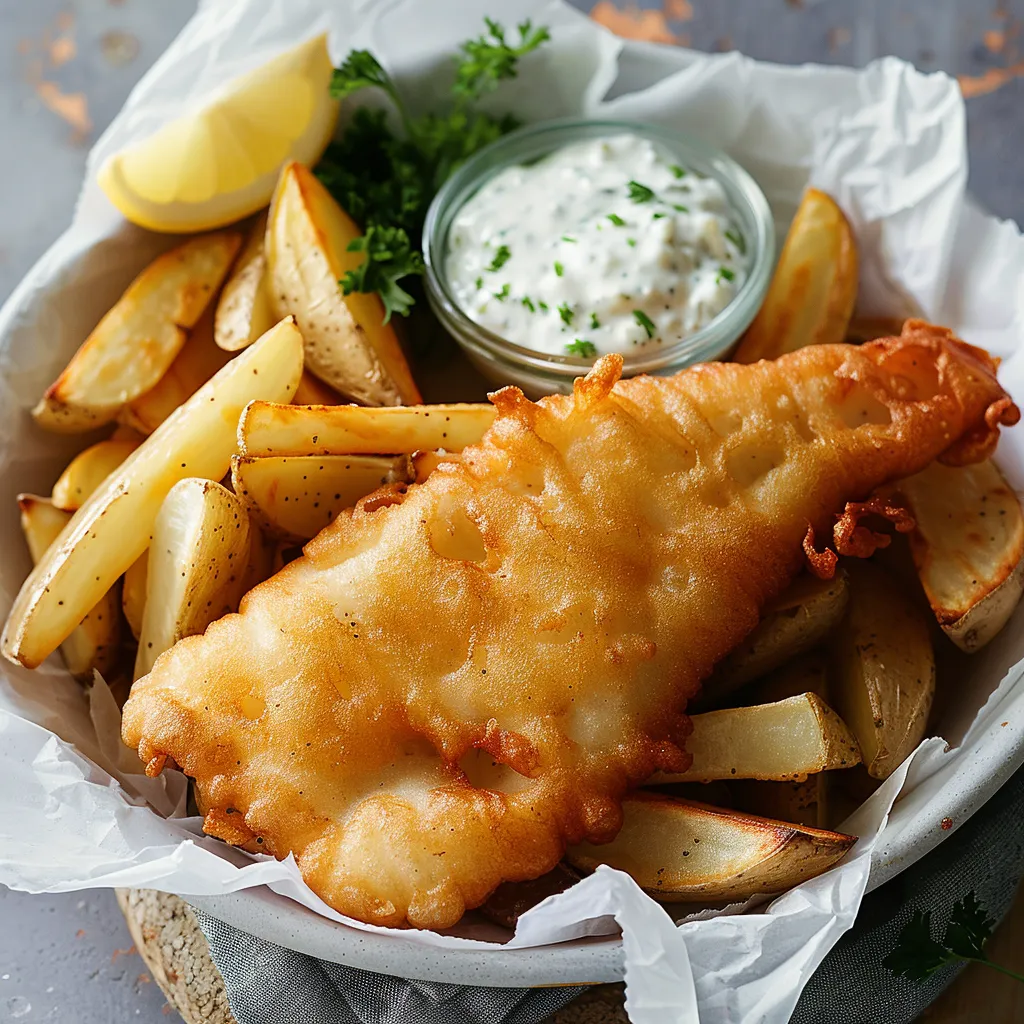 Pin it
Pin it
The perfect fish and chips combines golden-crispy batter encasing moist, flaky fish alongside properly chunky chips with crispy exteriors and fluffy centers. This British classic requires attention to detail and proper technique to achieve that authentic pub-quality result in your home kitchen.
After years of perfecting this recipe, I've discovered that the temperature of both batter and oil is crucial for achieving that signature crispy texture.
Essential Ingredients Guide
- Fresh White Fish Fillets: Choose pristine, properly dried fillets for the best texture and clean flavor. Drying ensures the batter adheres well.
- High-Starch Potatoes: Maris Piper or Russet potatoes are ideal for crispy, golden chips with a fluffy interior.
- Cold Beer or Soda Water: Essential for creating a light, airy batter that crisps up beautifully when fried.
- Premium Cornflour: Adds extra crispiness to the batter, helping achieve a delicate yet crunchy coating.
- Fresh Oil: Use an oil with a high smoke point, like vegetable or peanut oil, to ensure proper frying without burning.
- Sea Salt: Enhances the natural flavors of the fish and chips, providing the perfect seasoning.
- Plain Flour: Must be fresh and dry to create a smooth, consistent batter that coats the fish evenly.
Culinary Artistry
- Chip Creation:
- Cut potatoes into even batons approximately 1-cm thick. Par-boil carefully until just starting to soften but not breaking. Allow to steam dry completely before first frying. This creates the foundation for perfect texture.
- Batter Excellence:
- Keep beer or soda water ice-cold until mixing. Combine dry ingredients thoroughly before adding liquid. Whisk until just combined - small lumps are acceptable. Rest batter briefly to allow flour to hydrate properly.
- Fish Preparation:
- Pat fish completely dry with paper towels. Season lightly before coating. Dust with flour mixture first to ensure batter adheres properly.
- Frying Mastery:
- Maintain oil temperature precisely at 375°F (190°C) throughout cooking. Never crowd the pan - fish and chips need space to achieve proper crispiness.
 Pin it
Pin it
My British grandmother taught me to add a pinch of baking powder to the batter - it creates extra lightness that makes the coating irresistible.
Perfect Presentation
Serve this classic dish the traditional way - wrapped in brown paper or newspaper-lined baskets to absorb any excess oil. Arrange chunky chips alongside the golden fish, with lemon wedges and homemade tartar sauce in small ramekins. Consider adding a side of mushy peas or coleslaw for authenticity. Malt vinegar should be readily available for sprinkling over the chips.
Creative Adaptations
Explore different variations while maintaining authentic techniques. Create a spicier version by adding cayenne to the batter. Develop a gluten-free option using rice flour and gluten-free beer. Some chefs add a touch of curry powder to the batter for an Anglo-Indian twist, while others incorporate herbs like dill or parsley. For a lighter version, try using sparkling water instead of beer.
Storage Solutions
While fish and chips are best enjoyed immediately, leftovers can be stored carefully. Keep fish and chips separate in airtight containers in the refrigerator for up to two days. Reheat in a hot oven (400°F/200°C) on a wire rack to restore crispiness. Never microwave as this will make the batter soggy and the chips limp.
 Pin it
Pin it
Fish and chips represents the pinnacle of British comfort food. Through countless preparations, I've learned that success lies in respecting each component equally - from properly cut chips to perfectly battered fish. The combination of crispy, golden coating and moist, flaky fish creates a meal that's both satisfying and nostalgic. Whether served as a casual family dinner or for entertaining friends, this recipe brings the authentic taste of a British chippy right to your kitchen.
Frequently Asked Questions
- → What's the best fish to use?
- Cod or haddock are traditional choices, but any firm white fish works well. Choose thick fillets for best results.
- → Why use both flour and cornstarch?
- Cornstarch makes the batter lighter and crispier. The combination creates the perfect texture.
- → Can I make this without beer?
- Yes, club soda or seltzer water makes an excellent non-alcoholic substitute that still creates a light, crispy batter.
- → What oil temperature is best for frying?
- Maintain oil at 350-375°F (175-190°C) for optimal results. Too cool oil makes food greasy, too hot burns the outside.
- → How do I keep everything hot and crispy?
- Keep finished chips warm in a low oven while cooking fish. Serve immediately once everything is done.
